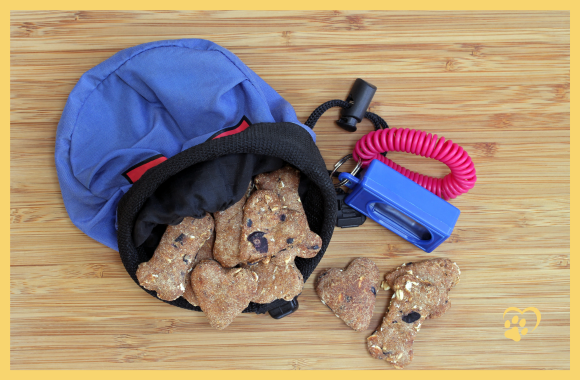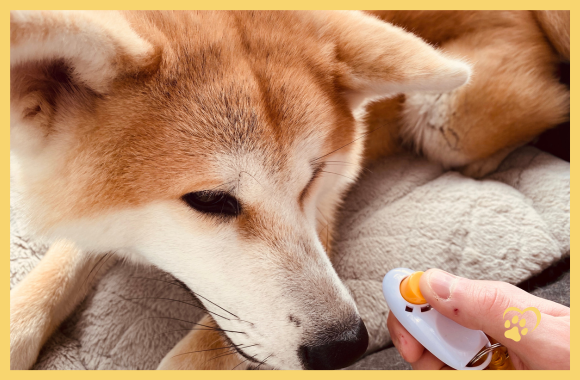You know that feeling when you're talking to your dog and it's like you're speaking two different languages? We all love our four-legged friends, but sometimes communication can be a challenge. That's where clicker training comes in - a simple but effective way to communicate with your dog. We'll explain how clicker training works and why it's so effective for teaching your dog new commands or correcting unwanted behavior. Whether you're an experienced dog owner or you've just brought home a new puppy, this training could revolutionize the way you interact with your dog.
Understanding Clicker Training: A Method with a History
Clicker training may seem like a modern idea at first glance. One little click, and the dog suddenly seems to want to recite Shakespeare's sonnets. But did you know that the clicker training method has been around for decades?
The definition of clicker training
Clicker training is a training method based on positive reinforcement. This means that your dog receives a reward when he does something right. The clicker itself is a small device that produces a distinct clicking sound. This sound is used to signal to your dog at exactly the right moment that he has done something right. Think of the clicker as an instant lob button. And who doesn't love instant praise?
The history of clicker training
You might think that clicker training is a relatively new invention. In fact, the history of clicker training goes back to the 1940s. Its origin lies in the work of B.F. Skinner, a famous psychologist who pioneered the field of operant conditioning.
Operant conditioning, it sounds pretty scientific, doesn't it? Let's break it down a little bit. Essentially, it means that a behavior becomes more likely to occur when it is rewarded. Think about your own experience: If you get a piece of chocolate every time you take out the trash, won't you take out the trash more often?
Skinner started with pigeons and rats, but it wasn't long before dog trainers also jumped on the bandwagon and started using these methods. Since then, clicker training has helped many dogs (and their owners) communicate and understand each other better. So it's not a new fad, but a proven method based on solid science. And who can resist good old science?
Clicker training in action: how it works and why timing is key
Now that we know what clicker training is and where it comes from, it's time to get into the details. How does clicker training actually work? And why is timing so important? Let's go through it step by step.
The typical course of a clicker training session
Clicker training is not witchcraft. It usually goes like this: You ask your dog to do something, such as sit down. When he sits, you immediately click the clicker and then give him a reward. The clicker is like a bridge between the behavior and the reward. It tells your dog, "You just did that right. Here comes your reward!"
It is important that the click sound is heard at the exact moment your dog is performing the desired behavior. Think of it like a photograph that captures the exact moment your dog does something right. And just like a good photo, timing is key.
The role of the clicker and timing in training
Timing is absolutely critical in clicker training. The clicker must be triggered at the exact moment the dog exhibits the desired behavior, not a second earlier or later. Why? Because dogs live in the here and now. They don't understand that they are being rewarded because they did something right five minutes ago. They need to see the connection between their behavior and the reward immediately.
This is where the clicker comes in. The clicker is like an instant message that tells the dog, "That was great, here's your reward!". And the best part? It works with any dog, big or small, young or old. It's like a universal dog language that every dog understands.

The effectiveness of clicker training: why it works so well
Now we have clarified what clicker training is and how it works. But why is it so effective? Why bother with a little plastic clicker when you could just say "good dog"? Well, the answer lies in psychology and some pretty clever principles of learning theory.
Psychological principles behind clicker training
There are two pretty clever psychological principles behind clicker training: classical and operant conditioning. Sounds complicated? We'll explain it to you.
Classical conditioning was discovered by the famous psychologist Ivan Pavlov. He observed that dogs began to drool when they heard the ringing of a bell associated with food. Similarly, with the clicker, the dog learns that the click sound means a reward and reacts to it.
Operant conditioning, mentioned earlier, kicks in when your dog learns that a certain behavior leads to a reward. Every time your dog sits and you click to give him a reward, he learns, "Sitting brings me positive things!"
Why clicker training is often faster and more effective
The beauty of clicker training is that it is often faster and more effective than other training methods. This is because the clicker sends a clear and unambiguous message to the dog. There is no guesswork, no confusion. Just one click that says, "Yes, you did that right!
Besides, the click is faster and more consistent than our human voice. Good dog" can be said in a hundred different ways, depending on mood, stress level and so on. But a click is always a click. And that is much easier for your dog to understand.
By the way, did you know that dolphins and even chickens are trained with the clicker? It is a universal method that works across species. And if it works for a chicken, it will certainly work for your beloved four-legged friend!
You can find further information in our articles:
- Mastering clicker training: The most important do's and don'ts to make it a success.

- Successful Clicker Training: Solutions to the Most Common Problems and Obstacles

- The Basics of Clicker Training for Puppies: The Guide to Getting Started Right

The many advantages of clicker training: More than just a toy
Now that we understand the effectiveness of clicker training, it's time to explore the many benefits of this ingenious training tool. Yes, the clicker is definitely more than just a little plastic toy. It can improve communication with your dog, strengthen bonding, and much more. Sound interesting? Then read on!
Improved communication and stronger bond
One of the greatest benefits of clicker training is improved communication between you and your dog. The clicker is like a bridge that bridges the gap between man and dog. It sends a clear and unmistakable message to the dog, "You did good!". And the beauty of it is that your dog understands this message, no matter what language you speak.
But that's not all. Clicker training can also strengthen the bond between you and your dog. Think about it: Every time you train with the clicker, you spend time with your dog, you interact with each other, you have fun together. And all of this can help deepen and strengthen your bond.
Did you know that dogs trained with the clicker are often more excited and motivated when it's time for training? They associate the clicker with positive experiences and therefore look forward to training. And a happy dog is a well-trained dog!
The advantages of clicker training concisely summarized
- Improved communication: The clicker provides a clear and consistent method of communication between you and your dog.
- Stronger bond: Positive and reward-based training strengthens the bond between you and your dog.
- Effective learning: Clicker training utilizes the dog's natural learning mechanisms and can therefore be more effective than traditional training methods.
- Adaptability: Clicker training can be used for a variety of behaviors and commands, from simple tricks to complex tasks.
- Positive reinforcement: Instead of punishing negative behavior, positive behavior is encouraged through reward, resulting in a happier and more confident dog.
- Fast results: Many dog owners report that they see results faster with clicker training than with other training methods.
- Fun for the dog: Many dogs find training with the clicker very entertaining and look forward to the training sessions.
- Suitable for all ages: From puppies to seniors, dogs of all ages can benefit from clicker training.
- Easy to learn: The principle of clicker training is easy to understand and implement for both the dog and the owner.

Clicker training for beginners: The right start
Your interest in clicker training is piqued? Great! Then why don't you get started right away? How do you actually get started? And are there certain tips and tricks you should know? We have summarized everything for you. So, grab your dog and clicker and let's get started!
The first click: Introduction of the clicker
The first step in clicker training is what is called "charging" the clicker. No, this does not mean plugging it into an electrical outlet! Charging the clicker means that your dog learns to associate the click with a reward.
It's very simple. Just click and give your dog a treat immediately after. Repeat this process a few times until your dog is looking at you expectantly with each click. Congratulations, your clicker is now "loaded"!
The training process
The principle of clicker training is simple: you click and reward whenever your dog performs the desired behavior. This can be anything from sitting to bringing a toy to turning on the light.
Start with simple exercises and slowly increase the level of difficulty. And remember: patience is the key to success. Your dog is not a robot and it is normal that he sometimes makes mistakes. Stay calm and patient and you will soon reap the fruits of your labor.
Our best tips and tricks
Finally, we have a few tips and tricks for you that can help you get started with clicker training:
- Timing is everything: The click must come exactly when your dog shows the desired behavior. A click too early or too late can confuse your dog.
- Vary the rewardsNot every reward has to be a treat. Petting, praise or the favorite toy can be just as effective.
- Keep the training sessions short: 5-10 minutes are often more effective than half an hour. Several short workouts spread throughout the day are ideal.
- Stay consistent: Once you have started clicker training, you should stick with it. Use the clicker only for training and not as a toy or for contact.
Now you are ready to explore the world of clicker training. Have fun with it!
